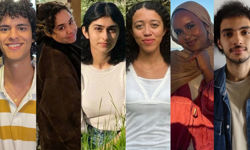
This year’s British Journalism Awards should be good news for women. Just under half of the shortlist was made up of female reporters, along with half of all the winners on the night. It’s a far cry from a decade ago when just 27 per cent of the shortlist were women and just 10 per cent of the winners. It’s undoubtedly progress – but do these figures tell the whole story?
Data analysis of the same awards revealed women were much less likely to be nominated in categories like investigations, politics, finance and sports. In the latter, just eight per cent of those shortlisted were women. The only categories where women came out on top were arts and entertainment, diversity and inclusion, and the new journalist category.
Meanwhile, a report commissioned by the Bill and Melina Gates Foundation found that there are at least two male editors-in-chief for every woman in the position in the UK. They also reported that women of colour face “extraordinarily dire” situations and are “locked out of top editorial jobs”.
Women from working-class backgrounds, disabled journalists, LGBTQ+ writers, and those from other marginalised backgrounds also face additional barriers. In short, our work is far from done and it’s vital we now push past just the headline statistics.
Publishers Must Look Beyond Topline Statistics
“It’s good that the amount of women in media is tracked – but it needs to go further than that,” says Rachel Charlton-Dailey. Charlton-Dailey is the founder of The Unwritten, a publication that gives disabled people a space to write about their lives without them “being reduced to traumatic clickbait or an inspirational story”. Last year, she won Women in Journalism’s Georgina Henry Award for Digital Innovation.
She continues: “How many of these women are white, middle-class, non-disabled, straight women who went to good schools and maybe even have a family member in media? These are the questions we need to be answering. We need to see stats for how many disabled women are in the media, how many black women, queer women, how many are from outside of London.”
It simply isn’t enough in 2023 to just be tracking the number of women you have in your newsroom. Publishers that truly care about inclusion and reflecting their audiences need to be thinking about where women are in their newsrooms as well as which women are in their newsrooms.
Intersectional thinking is crucial – none of us fit into just one box. We’re all shaped by a multitude of political and social identities, each bringing a unique combination of privileges and disadvantages. Publishers must recognise this and widen their efforts around inclusion.
Hannah Ajala is the founder of We Are Black Journos, a community that provides space for both established and aspiring black journalists to find belonging. “Diversity and inclusion is not a box-ticking exercise. You literally need it to have a better understanding of the society that you’re talking to,” Ajala tells InPublishing. “Any news organisation and any editorial team owe it to themselves to actually show that they’re doing the work.
“You know you’re doing it the right way when Stormzy has dropped an album and you don’t need to run to the fifth floor to find out who Stormzy is. People who know who he is without even having to touch Google. That really shows you the importance of community.
“Community should not look the same. Community shouldn’t all be from the same social class, the same ethnic group. Community shouldn’t be the same gender. It should be a plethora of everything. It needs to reflect society, otherwise, there is a danger of your narratives looking one-sided and biased.”
However, Ajala is keen to stress that reporting and tracking diversity is just the beginning. “I do understand the need for these reports to be published because this educates people about the decline of black women in senior places. It makes us question; who needs to take this into account? Is it HR? Is it the editor? Where should this key information go?”
Establishing An Equitable Recruitment Framework
Newsrooms need to make sure they have a senior leader responsible for and assessing the success of equity efforts. Everyone in the newsroom needs to play their part, but serious and meaningful commitment from the top is vital.
Equity for women in newsrooms encompasses all parts of the employment journey, from the moment you think about hiring someone to their very last second working for the company. For too long, HR departments have just thrown out the same old job adverts, written in the same way, and sent to the same people.
“Fairness is about recognising that people, and especially the young people we work with, experience life differently,” writes Aksana Khan, the community careers officer at Arts Emergency, a charity which helps young people take their first steps into the creative industry.
“Because of this, traditional CVs, cover letters and written applications are not always the best way to assess if someone is right for your organisation and the opportunity. Alternatives that you could consider might be asking for a personal biography, a portfolio of work or responding to a short creative brief.”
She also recommends questioning the requirements listed in job descriptions – why must someone have a degree, a driving licence, or set amount of experience? Always explain why you need certain criteria, check you’re using inclusive language, and make the effort to outreach to communities that may not otherwise see your adverts.
Inclusive and transparent adverts are just as important at higher level roles – at many newsrooms, inequality between men and women’s pay has risen since gender pay gap reporting was first introduced, while research from LinkedIn shows that women apply for 20 per cent less jobs than men despite similar job searches. In other words, we talk ourselves out of jobs.
Creating An Inclusive Newsroom Environment
Once in newsrooms, inequalities still persist. Women remain more likely to be assigned lifestyle or “softer” beats than men, with many saying they often feel expected to “mine their trauma” to get a foot in the door, or feel pigeonholed into writing about certain areas of their identity. A study by Women in Journalism also found that 81 percent of women journalists felt locked out of “high status” specialisms.
Suyin Haynes is the editor-in-chief of gal-dem, a media company dedicated to sharing the perspectives of people of colour from marginalised genders. Haynes tells InPublishing there is often a “well meaning lens to editing” where people from marginalised communities are automatically assigned to cover issues from their community, without thinking of the consequences.
“Maybe that’s not even that reporter’s expertise or beat? Maybe it’s not something that reporter feels comfortable approaching in terms of mental health or their closeness to the story. And I’ve seen that time and time again – ‘X reporter is from X community so they can cover this story’. Even though well meaning, it leans into tokenising.”
While diversity in the newsroom is vital to covering stories in an authentic and nuanced way, managers and editors must take care to avoid pigeonholing and stereotyping writers, taking the time to understand reporters’ ambitions and expertise.
Establishing A Pipeline To The Top Of The Industry
Supporting women within the newsroom is vital to progression. While the last few years have seen a number of high-profile appointments for women, from Roula Khalaf at the Financial Times to Victoria Newton at The Sun, women still make up less than 40 percent of top editors.
Research by Women in Journalism shows three-quarters of women journalists find the industry’s culture “macho and intimidating”, with 70 percent saying senior roles are dominated by men. The problem only intensifies for those from marginalised backgrounds.
Haynes comments: “It’s a really pervasive problem. In the last seven years, we’ve seen a lot of schemes, traineeships and attempts at routes in for women and non-binary people of colour. But there’s not necessarily a trajectory upwards.”
Ajala also adds that having senior figures in power can help break bad hiring practices, where people hire in their own image. “If there were more non-white people in senior positions, could that possibly trickle down to teams and the overall workforce? It’s almost like looking at the route of how we can stop the same cycle from happening again.”
Alongside career progression, newsrooms also need to look closely at policies on flexible working. Eighty-three per cent of respondents to the Women in Journalism research said they felt women were more likely to go freelance due to inflexible and antisocial demands of the job with home life.
“It’s high-pressure, long hours and sometimes lots of stress,” says Donna Ferguson, an award-winning freelancer who now runs masterclasses for Women in Journalism. Previously an editor in-house, she went freelance after having a baby. Coupled with the gender pay gap and financial pressure, she says, “it can be quite tempting for women”. For her, it was the “best career move I ever made”.
However, even for freelancers there are issues. Emma Wilkinson is one of the co-founders of Freelancing for Journalists, an organisation that offers training and support to anyone who wants to make it work as a freelancer. Emma points to issues such as late payments, payment on publication, and kill fees. “These are issues that will affect women disproportionately because they are more likely to freelance,” she adds. “Pensions can also be a big issue.”
Not only do newsrooms need to be flexible in order to keep senior women on staff, they also need to be mindful of the power dynamic they hold with freelancers, and how this can disproportionately affect women. Most importantly though, it’s about being open to learn.
Haynes concludes: “It’s so important to stay curious and stay humble. And although we are really, really proud of what we do, we also still have learning to do. I think it’s really important to be thinking about that, never be complacent or take it for granted.”
Further reading
- From Outrage to Opportunity: How to Include The Missing Perspectives of Women of All Colors in News Leadership and Coverage
- Write better job ads: Community Careers Officer Aksana Khan shares her advice for recruiting young people
- Gender pay gap
- Gender Insights Report: How women find jobs differently
- The Gender News Gap: The Impact of Inequality in Journalism & Media
- Women and leadership in the news media 2022: evidence from 12 markets
This article was first published in InPublishing magazine. If you would like to be added to the free mailing list to receive the magazine, please register here.












